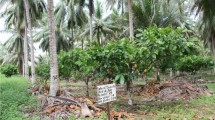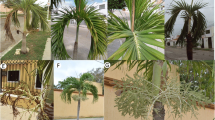Abstract
Phytoplasmas are associated with the lethal disease of coconut palms in Tanzania (LDT). It is a destructive lethal yellowing-type syndrome (LYTS) exhibiting differences in losses between the southern districts and the northern districts. To explain these differences, the existence of variable pathogenic strains of the LDT phytoplasma was investigated using ribosomal RNA gene PCR primers. A total of 84 samples were collected from 67 palms in 14 coastal districts of Tanzania, including the low, moderate, and high incidence areas. Of these, 38 samples were studied in detail. Detected phytoplasma rDNA was characterized by either sequencing of the PCR products and/or restriction fragment length polymorphism (RFLP). Sequence analysis of the P1/P7-primed PCR products revealed several positions of variability, making it possible to distinguish two main geographical clusters. The northern cluster included samples from Tanga region only and is associated with low/moderate disease incidence. A second larger cluster included samples from the rest of the coastline between Bagamoyo and Mtwara. Five genotypes could be identified based on mutations/deletions in the P1/P7 PCR product, two within the northern cluster, and three within the southern cluster. The geographical distribution of the two clusters and the genotypes could be related to the history of coconut introductions in Tanzania. The sequences obtained also confirm that the phytoplasmas associated with LDT are significantly different from all of the other phytoplasmas associated with coconut lethal yellowing-type syndromes worldwide, and it is proposed that these phytoplasmas should be classified into their own 16Sr group.






Similar content being viewed by others
Data availability
All data generated or analyzed during this study are included in this published article.
References
Deng S, Hiruki C (1991) Amplification of 16S rRNA genes from culturable and nonculturable mollicutes. Journal of Microbiological Methods 14:53–61
Dollet M, Quaicoe RN, Pilet F (2009) Review of coconut “lethal yellowing” type diseases diversity, variability and diagnosis. OCL 16:97–101
Doyle JJ, Doyle JL (1990) Isolation of plant DNA from fresh tissue. Focus 12:13–15
Gunn BF, Baudouin L, Olsen KM (2009) Independent origins of cultivated coconuts (Cocos nucifera L.) in the old-world tropics. PLoS ONE 6:e21143
Harrison NA, Richardson PA, Jones P, Tymon A, Eden-Green SJ, Mpunami A (1994) Comparative investigation of mycoplasma-like organisms (MLOs) associated with Caribbean and African coconut lethal decline diseases by DNA dot hybridization and PCR assays. Plant Disease 78:507–511
Harrison NA, Myrie W, Jones P, Carpio ML, Castillo M, Doyle MM, Oropeza C (2002) 16S rRNA interoperon sequence heterogeneity distinguishes strain populations of palm lethal yellowing phytoplasma in the Caribbean region. Annals of Applied Biology 141:183–193
Harrison NA, Carpio ML, Davis RE, Jomantiene R (2004) Organization of two heterologous rRNA operons and adjacent genes in the palm lethal yellowing phytoplasma genome. In: Proceedings of the Fifteenth International Congress of the International Organization for Mycoplasmology; 2004. Athens, Georgia, p.127
Harrison NA, Helmick EE, Elliott ML (2008) Lethal yellowing-type diseases of palms associated with phytoplasmas newly identified in Florida, USA. Annals of Applied Biology 153:85–94
Harrison N, Davis RE, Oropeza C, Helmick E, Narvaez M, Eden-Green S, Dollet M, Dickinson M (2014) ‘Candidatus Phytoplasma palmicola’, a novel taxon associated with a lethal yellowing-type disease (LYD) of coconut (Cocos nucifera L.) in Mozambique. Journal of Systematic and Evolutionary Microbiology 64:1890–1899
Hodgetts J, Boonham N, Mumford R, Harrison N, Dickinson M (2008) Phytoplasma phylogenetics based on analysis of secA and 23S rRNA gene sequences for improved resolution of candidate species of ‘Candidatus Phytoplasma’. International Journal of Systemic and Evolutionary Microbiology 58:1826–1837
Jomantiene R, Davis RE, Valiunas D, Alminaite A (2002) New group 16SrIII phytoplasma lineages in Lithuania exhibit rRNA interoperon sequence heterogeneity. European Journal of Plant Pathology 108:507–517
Kullaya AK, Mpunami A (2008) Breeding for resistance to coconut lethal disease in Tanzania. In: Proceedings of an International Workshop on Lethal Yellowing Disease of Coconut, 3–5 June 2008, Accra, Ghana. CIRAD (Centre de coopération internationale en recherche agronomique pour le développement), France
Kullaya A, Mpunami A, Harries HC, Schuiling M, Kaiza DA (1995) Screening for resistance to the coconut lethal disease in Tanzania and prospects for rehabilitation. In: Eden-Green SJ, Ofori F (eds) Proceedings of the International Workshop on Lethal Yellowing-Like Diseases of Coconut, Elmina, Ghana, pp 168–72
Kullaya A, Mkumbo K, Sallu R, Tembo S, Masumbuko L (2001) Characterization of the local coconut Germplasm using RAPD markers. Breeding and seed production. In: Twenty-five years of coconut research in Tanzania. Mikocheni Agricultural Research Institute
Lee IM, Gundersen-Rindal DE, Davis RE, Bartoszyk IM (1998) Revised classification scheme of phytoplasmas based on RFLP analyses of 16S rRNA and ribosomal protein gene sequences. International Journal of Systematic Bacteriology 48:1153–1169
Liefting LW, Andersen MT, Beever RE, Gardner RC, Forster RLS (1996) Sequence heterogeneity in the two 16S rRNA genes of Phormium yellow leaf phytoplasma. Applied and Environmental Microbiology 62:3133–3139
Marinho VL, Fabre S, Dollet M (2008) Genetic variability among isolates of coconut lethal yellowing phytoplasmas determined by heteroduplex mobility assay (HMA). Tropical Plant Pathology 33:377–380
Martinez RT, Narvaez M, Fabre S, Harrison N, Oropeza C, Dollet M, Hichez E (2008) Coconut lethal yellowing on the southern coast of the Dominican Republic is associated with a new 16SrIV group phytoplasma. Plant Pathology 57:366
Mpunami AA, Tymon AM, Jones P, Dickinson MJ (1999) Genetic diversity in the coconut lethal yellowing disease phytoplasmas of East Africa. Plant Pathology 48:109–114
Mpunami A, Tymon A, Jones P, Dickinson MJ (2000) Identification of potential vectors of the coconut lethal disease phytoplasma. Plant Pathology 49:355–361
Mpunami AA, Mugini JA, Tembo PM, Chalamila S, Luka FS (2008) Epidemiology of the coconut lethal disease in Tanzania. In: Proceedings of the International Workshop on Lethal Yellowing Diseases on Coconut, 2008. Accra, Ghana, p 170–82
Nei M, Li WH (1979) Mathematical model for studying genetic variation in terms of restriction endonucleases. Proceedings of the National Academy of Sciences of the USA 76:5269–5273
Nienhaus F, Schuiling M, Gliem G, Schninzer V, Spittel A (1982) Investigations on the etiology of lethal disease of coconut palm in Tanzania. Zeitschrift fur Pflanzenkranheiten und Pflanzenschutz 89:185–193
Pilet F, Quaicoe RN, Osagie IJ, Freire M, Foissac X (2019) Multilocus sequence analysis reveals three distinct populations of “Candidatus Phytoplasma palmicola” with a specific geographical distribution on the African continent. Applied and Environmental Microbiology 85:e02716–e02718
Rohde W, Kullaya A, Mpunami A, Becker D (1993) Rapid and sensitive diagnosis of mycoplasma-like organisms associated with lethal disease of coconut palm by a specially primed polymerase chain reaction for the amplification of 16S rDNA. Oleagineux 47:511–515
Schuiling M, Harries HC (1994) The coconut palm in East Africa. 1. East African tall. Principes 38:4–11
Schuiling M, Mpunami A (1992) Lethal disease of coconut palm in Tanzania. I. Comparison with other coconut diseases in East Africa. Oleagineux 47:511–515
Schuiling M, Nienhaus F, Kaiza DA (1981) The syndrome in coconut palms affected by a lethal disease in Tanzania. Zeitschrift fur Pflanzenkranheiten und Pflanzenschutz 88:665–677
Schuiling M, Mpunami A, Kaiza DA (1992) Lethal disease of coconut palm in Tanzania. II. History, distribution and epidemiology. Oléagineux 47:516–522
Smart CD, Schneider B, Blomquist CL, Guerra LJ, Harrison NA, Ahrens U, Lorenz KH, Seemuller E, Kirkpatrick BC (1996) Phytoplasma-specific PCR primers based on sequences of the 16S-23S rRNA spacer region. Applied and Environmental Microbiology 62:2988–2993
Steiner KG (1978) Suspected lethal yellowing disease of coconut palms in Tanzania. FAO Plant Protection Bulletin 26:10–12
Tamura K, Stecher G, Paterson D, Filipski A, Kumar S (2013) Molecular evolutionary genetics analysis version 6.0. Molecular Biology and Evolution 30:2725–2729
Tymon A, Jones P, Harrison NA (1998) Phylogenetic relationships of coconut phytoplasmas and the development of specific oligonucleotide PCR primers. Annals of Applied Biology 132:437–452
Wei W, Davis RE, Lee IM, Zhao Y (2007) Computer-simulated RFLP analysis of 16S rRNA genes: identification of ten new phytoplasma groups. International Journal of Systematic and Evolutionary Microbiology 57:1855–1867
Wei W, Lee IM, Davis RE, Suo X, Zhao Y (2008) Automated RFLP pattern comparison and similarity coefficient calculation for rapid delineation of new and distinct phytoplasma 16Sr subgroup lineages. International Journal of Systematic and Evolutionary Microbiology 58:2368–2677
Acknowledgements
Financial and logistical support from CIRAD for Dr. Mpunami to work at CIRAD is highly acknowledged. MD thanks his colleague Denis Depommier, Cirad regional Director in Kenya, for his precious help in setting up our visit to Tanzania, and later for his support in setting up AM’s stay at Cirad in Montpellier. Technical support from Joel Erasto in DNA extraction and Gideon Nyalusi for sampling in the southern regions are also appreciated. FP acknowledges funding by the European Union under the European Regional Development Fund, the Conseil Régional de La Réunion, and the Centre de Coopération Internationale en Recherche Agronomique pour le Développement (CIRAD).
Author information
Authors and Affiliations
Contributions
AM: field survey, investigation, review and editing. FP: investigation, validation, visualization, co-writing—original draft, review and editing. SF: resources, investigation, validation. AK: field survey, project administration (Tanzania), resources. Matthew D: investigation, supervision, validation, visualization, review and editing. Michel D: conceptualization, project administration (France), funding acquisition, resources, investigation, supervision, validation, visualization, co-writing—original draft, review and editing.
Corresponding author
Ethics declarations
Conflict of interest
The authors declare that they have no conflict of interest.
Additional information
Publisher’s note
Springer Nature remains neutral with regard to jurisdictional claims in published maps and institutional affiliations.
Rights and permissions
About this article
Cite this article
Mpunami, A., Pilet, F., Fabre, S. et al. Spatial distribution of the different strains of the distinct coconut lethal yellowing-type phytoplasma species associated with the syndrome in Tanzania. Trop. plant pathol. 46, 207–217 (2021). https://doi.org/10.1007/s40858-020-00407-z
Received:
Accepted:
Published:
Issue Date:
DOI: https://doi.org/10.1007/s40858-020-00407-z




